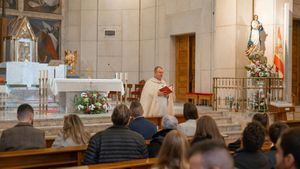Archaeologists in Sweden recently stumbled upon something unexpected during what was meant to be a routine excavation of a Stone Age site: ancient Viking burial grounds featuring mysterious carved rocks. Initially aimed at clearing land for a new roundabout and utility pipes near Tvååker, southern Sweden, this dig turned out to be far more significant than anyone had anticipated.
When excavators first arrived at the site, they thought they might find the remnants of early settlements based on ancient flirtations with the soil. What they didn’t expect was unearthing 139 Viking Age graves interspersed with human and animal remains, all sharing space with three large stone settings shaped like ships. Petra Nordin, the project leader, described the excavation’s slow initial beginning back in May 2017. "When we did the preliminary excavation, we found five graves, but soon realized there was much more — this large Viking burial ground was waiting to reveal itself to us."
Just about six percent of the burial ground has been excavated so far, leaving plenty of intrigue for upcoming discoveries. It’s not every day one uncovers evidence of Viking funerals complete with ship-like rock formations potentially used as grave markers. The presence of these stones suggests they were significant to Viking funeral practices, where ships often held deep cultural importance.
The burial mounds include one enormous formation reaching 164 feet long, crafted to resemble a ship. Many of these mounds were thought to utilize parts of actual ships, which were ritually burned long ago. Anders Kiellin, another archaeologist on the project, noted, "Sometimes we use metal detectors to find objects, which guide us to other graves, and it allows us to piece together the past, bit by bit."
Evidently, cremation was common during this period, and archaeologists have found many remains bearing signs of exposure to flames. Alongside human remains, they've also encountered burnt animal bones from cows, pigs, and dogs, hinting at food sacrifices associated with these rituals. According to Nordin, after bodies were burned, the remains of animals were typically placed atop the pyres before the graves were sealed. “The most common animal remains we find are from cattle, indicating they were probably offered as food sacrifices for the deceased,” she elaborated.
This excavation has drawn interest not only for its findings but also for the unanswered questions it has raised. For one, archaeologists are now piecing together the mystery of where these Vikings lived. The lack of dwelling structures around the graves has led experts to theorize about the existence of nearby villages. Was there once substantial settlement nearby? Nordin mentioned conversations hinting at possible Viking-era trading posts located near the excavation site or along the Tvååker River. It raises exciting possibilities about lifestyle and trade routes long concealed by time.
“We know this area was important for transportation, with routes running along the river and connecting to crossing roads, but its residential history remains shrouded in mystery," Nordin expressed. "Is there a village at the old harbor or near the burial site? The education we gain from the artifacts pushes us to find these answers.”
So far, excavators have uncovered various artifacts, including ceramics and coins dating back to around 795 to 806 A.D., aligned with the era of the oldest graves. They even found silver buckles and tools, marking the utility and cultural richness of those who once walked this land. Interestingly, some of these artifacts bear significant scorch marks, documenting their ritual use during cremation practices.
But the excavation is far from over. With much of the burial ground yet to be explored, every layer uncovered adds more pieces to this rich historical puzzle. The team remains hopeful, not just for more artifacts but for insights about Viking life and culture. What they’ve achieved so far is turning heads not only within archaeological circles but also within the broader cultural narrative of the Vikings’ time and influence.
While thoughts about the Vikings often lean toward their exploits as sea raiders and warriors, this new exploration frames them within the depths of their cultural practices, rituals, and the complexity of their societal structures. Every burial ground holds secrets of past lives, but this one seems particularly potent with stories yearning to be shared.
Archaeologists here work under the weight of time, balancing between the methodical pace of excavation and the ever-present thrill of discovery. Each stone unearthed, each grave excavated pulls them back centuries, inviting them to listen to the whispers of the past.
Stay tuned as this archaeological saga continues to evolve, promising new revelations about the Vikings and the world they inhabited. The grave markers are just the beginning of what could rewrite portions of history and shed light on long-held mysteries about these enigmatic seafarers.



